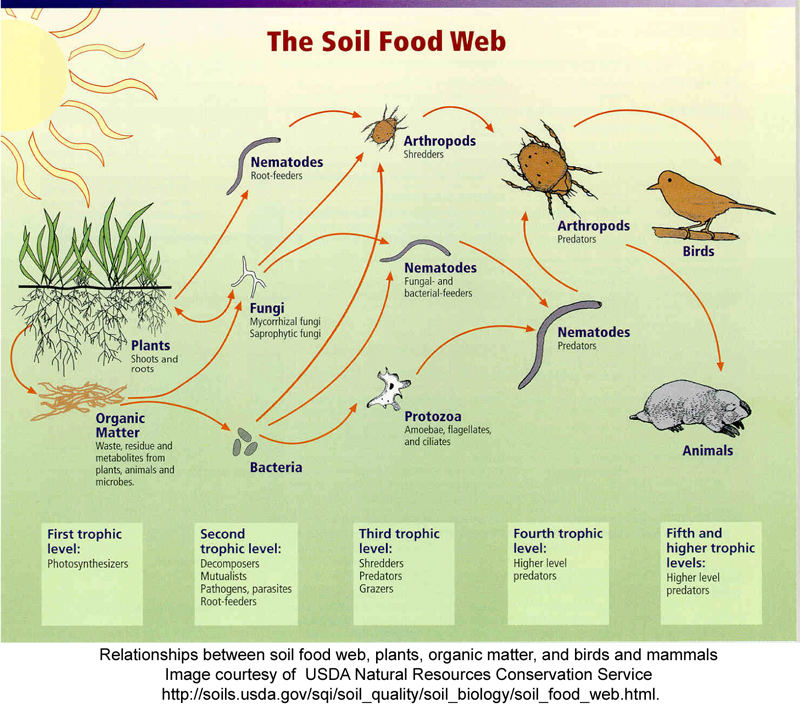About The Soil Food Web
What Is The Soil Food Web?

If we look at the food chain of the animal kingdom, we see that some members of the food chain don’t just eat one thing – so the reality is more of a web than a chain. There is a food web in the soil as well, which is made up of bacteria, fungi, insects, earthworms to name just a few.
Dr. Elaine Ingham has pioneered research into the microorganisms in the soil for the past 40 years. She has worked with a team of research scientist to understand how they interact with each other and with plants.
The soil food web can be thought of as the soil’s biome, which breaks down organic matter and releases nutrients in plant available form. The soil food web protects against pests, diseases, drought and flooding.
why do we need the soil food web?
Heavy machinery such as ploughing compacts the soil and looses its’ structure. This leads to soil erosion because when it rains, top soils are being washed away. The compaction layer also makes the plant roots unable to grow as deep as necessary to reach the water table which increases the need for watering.
Inorganic fertilisers contain a lot of salt which means the plant either cannot take it up or if they do they also have to take up extra water which stresses the plant. Just like if you start drinking salt water, you pull water out of your body tissues to dilute the salt which can cause a life threatening form of dehydration. Inorganic fertilisers also dissolve in water and therefore every place where water moves it is bringing the excess salt with it. Applying chemicals such as pesticides and herbicides becomes necessary because the soil has no immune system left however these chemicals kill the biology in the soil such as fungi and protozoa and we are left with only bacteria. This results in a system breakdown.
If you apply inorganic fertilisers to a healthy system where everything is functioning properly you see no difference. When you put an inorganic fertiliser and the plants respond and grow faster that says the nutrient cycle that is supposed to be there is broken. It shows that plants have become dependent on you supplying inorganic nutrient which is expensive and costs you time and money.
Wouldn’t it be better to put back the proper biology once and solve this problem forever?
how can we fix the soil?
The good news is that we can restore the soil food web to most soils within just a few months. This results in a number of benefits both for farmers and for the environment such as:
- Eliminates the need for fertiliser The correct biology makes nutrients available to the plants at the rate they need it
- Retains nutrients Stops run off/ leaching
- Suppresses disease Competition, inhibition, consumption; no more pesticides
- Builds soil structure Reduces water use, increases water holding capacity, increase root depth
- Suppress weeds
- Sequester carbon
- Decomposes toxins
The first step in the process is to find out what is going on in your soil right now by sending in soil samples to us to be assessed by a Qualified Soil Food Web Technician. This will provide you with a report on the current biology in your soil.
A qualified Soil Food Web Consultant will provide you with a plan to fix your soil using BioComplete™ Soil Amendments which can be created on your farm.
With a balanced soil food web in place farmers don’t need to use fertilisers, pesticides or herbicides. Regenerating the soil food web means you will save money on chemical inputs, it also means that your yields increase dramatically. In some cases, farmers working with Dr. Elaine Ingham have seen yields increase by over 136%.
Mission
Supporting our clients to regenerate their soil and have higher yields while making plants, people and food systems more resilient and healthier.
Vision
Worldwide farming methods which repair the environment and sustain life in all forms.
Values
- Collaboration with farmers
- Building resilience
- Stewardship with nature

